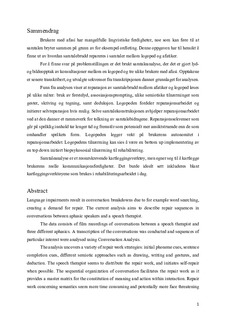Reparasjonsstrategier i samtalebrudd mellom logoped og afatiker - en samtaleanalytisk tilnærming i et interaksjonistisk perspektiv på institusjonell kommunikasjon
Master thesis
Permanent lenke
http://hdl.handle.net/11250/2455365Utgivelsesdato
2017Metadata
Vis full innførselSamlinger
Sammendrag
Sammendrag
Brukere med afasi har mangelfulle lingvistiske ferdigheter, noe som kan føre til at samtalen bryter sammen på grunn av for eksempel ordleting. Denne oppgaven har til hensikt å finne ut av hvordan samtalebrudd repareres i samtaler mellom logoped og afatiker.
For å finne svar på problemstillingen er det brukt samtaleanalyse, der det er gjort lyd- og bildeopptak av konsultasjoner mellom en logoped og tre ulike brukere med afasi. Opptakene er senere transkribert, og utvalgte sekvenser fra transkripsjonen danner grunnlaget for analysen.
Funn fra analysen viser at reparasjon av samtalebrudd mellom afatiker og logoped løses på ulike måter: bruk av førstelyd, assosiasjonsprompting, ulike semiotiske tilnærminger som gester, skriving og tegning, samt deduksjon. Logopeden fordeler reparasjonsarbeidet og initierer selvreparasjon hvis mulig. Selve samtalekonstruksjonen avhjelper reparasjonsarbeidet ved at den danner et rammeverk for tolkning av samtalebidragene. Reparasjonssekvenser som går på språklig innhold tar lenger tid og fremstår som potensielt mer ansiktstruende enn de som omhandler språkets form. Logopeden legger vekt på brukerens autonomitet i reparasjonsarbeidet. Logopedens tilnærming kan sies å være en bottom up implementering av en top down initiert biopsykososial tilnærming til rehabilitering.
Samtaleanalyse er et ressurskrevende kartleggingsverktøy, men egner seg til å kartlegge brukerens reelle kommunikasjonsferdigheter. Det burde ideelt sett inkluderes blant kartleggingsverktøyene som brukes i rehabiliteringsarbeidet i dag. Language impairments result in conversation breakdowns due to for example word searching, creating a demand for repair. The current analysis aims to describe repair sequences in conversations between aphasic speakers and a speech therapist.
The data consists of film recordings of conversations between a speech therapist and three different aphasics. A transcription of the conversations was conducted and sequences of particular interest were analysed using Conversation Analysis.
The analysis uncovers a variety of repair work strategies: initial phoneme cues, sentence completion cues, different semiotic approaches such as drawing, writing and gestures, and deduction. The speech therapist seems to distribute the repair work, and initiates self-repair when possible. The sequential organization of conversation facilitates the repair work as it provides a master matrix for the constitution of meaning and action within interaction. Repair work concerning semantics seem more time consuming and potentially more face threatening than repair work concerning morphology. The speech therapist seems to emphasise that the ultimate authority in the repair work resides with the aphasic speaker. One can argue that the speech therapist´s approach is the bottom up implementation of a top down initiated biopsychosocial approach to rehabilitation.
Conversation Analysis as a method is time consuming, but offers unparalleled resources for the analysis of pragmatic competence and should be considered among assessment tools used in aphasia rehabilitation.
